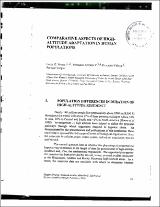Mostrar el registro sencillo del ítem
Comparative aspects of high-altitude adaptation in human populations
| dc.contributor.author | Moore, Lorna G | |
| dc.contributor.author | Armaza, Fernando | |
| dc.contributor.author | Villena, Mercedes | |
| dc.contributor.author | Vargas, Enrique | |
| dc.date.accessioned | 2021-05-21T16:35:37Z | |
| dc.date.available | 2021-05-21T16:35:37Z | |
| dc.date.issued | 2000 | |
| dc.identifier.uri | http://repositorio.umsa.bo/xmlui/handle/123456789/25219 | |
| dc.description.abstract | Abstract. The conditions and duration of high-altitude residence differ among high-altitude populations. The Tibetan Plateau is larger, more geographically remote, and appears to have been occupied for a longer period of time than the Andean Altiplano and, certainly, the Rocky Mountain region as judged by archaeological, linguistic, genetic and historical data. In addition, the Tibetan gene pool is less likely to have been constricted by small numbers of initial migrants and/or severe population decline, and to have been less subject to genetic admixture with lowland groups. Comparing Tibetans to other high-altitude residents demonstrates that Tibetans have less intrauterine growth retardation better neonatal oxygenation higher ventilation and hypoxic ventilatory response lower pulmonary arterial pressure and resistance lower hemoglobin concentrations and less susceptibility to CMS These findings are consistent with the conclusion that "adaptation" to high altitude increases with time, considering time in generations of high-altitude exposure. Future research is needed to compare the extent of IUGR and neonatal oxygenation in South American high-altitude residents of Andean vs. European ancestry, controlling for gestational age and other characteristics. Another fruitful line of inquiry is likely to be determining whether persons with CMS or other altitude-associated problems experienced exaggerated hypoxia during prenatal or neonatal life. Finally, the comparison of high-altitude populations with respect to the frequencies of genes involved in oxygen sensing and physiologic response to hypoxia will be useful, once candidate genes have been identified. | es_ES |
| dc.language.iso | en | es_ES |
| dc.publisher | Adv. Exp. Med. Biol. | es_ES |
| dc.subject | ALTURA | es_ES |
| dc.subject | ADAPTACIÓN A LA ALTURA | es_ES |
| dc.subject | POBLACIONES HUMANAS | es_ES |
| dc.title | Comparative aspects of high-altitude adaptation in human populations | es_ES |
| dc.type | Article | es_ES |

